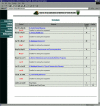A Web-based distance education course in nutrition in public health: case study
- PMID: 11720958
- PMCID: PMC1761899
- DOI: 10.2196/jmir.3.2.e16
A Web-based distance education course in nutrition in public health: case study
Abstract
Background: Strict work timetables, personal and professional duties or an inability to be absent from home or work can all represent major constraints for those wishing to improve their professional skills. Within this context, the World Wide Web can allow people to conveniently follow distance courses from their homes.
Objective: To present an experience in the use of the Web in the continuing education of healthcare professionals in Brazil.
Methods: A Web-based distance education course in nutrition in public health was developed. The methodology was an adaptation of both problem-based and task-based learning. At the end of the course an evaluation questionnaire which covered the course s contents, the educational methodology and resources, the duration and schedule, and the use of the Web as a tool for distance education was given to the students.
Results: There were 83 on line registrations from 13 states, 73 of the applicants were female, 62 had a degree in nutrition and 18 were physicians. From these; eleven students from ten states were chosen: nine female nutritionists, two female physicians, and one male physician. Seven students completed the course, took and passed the final exam. Of the other four students, two failed to follow the schedule, one had health problems, and one did not obtain the minimal score for sitting the final exam. The students had a mean age of 35, and a mean of ten years in practice. They all stated that they were unable to attend a regular course, even though they felt that they needed to improve their professional skills. Most of them studied seven days a week for between two and four hours a day. The students also felt that their professional skills had improved and each reported having made changes in their practice as a result of their participation. The students approved of the course s contents, methodology and resources, however they were divided about its duration. The Web as a tool in distance education was approved by the students. If it was not for the Web they could not have taken part in a continuing education program. All students said they would attend another virtual course, if available. Even though most of them did not have difficulty adapting to the virtual environment, they did feel that an adaptation period would be of value.
Conclusions: A Web-based course may be more effective than other distance education methodologies because it is more interactive and dynamic. On-line material can be constantly reviewed and updated, and the students can have the opportunity to submit commentaries or questions directly to the teaching staff. A Web-based course also allows the students to go beyond the course content as they learn how to search and take advantage of the huge resources of information available on the Internet.
Conflict of interest statement
None declared
Figures







References
-
- Bresnitz E A. Computer-based learning in PBL. Acad Med. 1996 May;71(5):540. - PubMed
-
- Harden RM, Laidlaw JM, Ker JS, Mitchell HE. Task-based learning: an educational strategy for undergraduate, postgraduate and continuing medical education. Part 1. Med Teach. 1996;18:7–13.
-
- Horn K D, Sholehvar D, Nine J, Gilbertson J, Hatton C, Richert C, Becich M J. Continuing medical education on the World Wide Web (WWW). Interactive pathology case studies on the Internet. Arch Pathol Lab Med. 1997 Jun;121(6):641–5. - PubMed
MeSH terms
LinkOut - more resources
Full Text Sources

